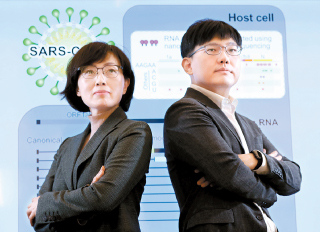Korean scientists map evolution of coronavirus

Professor Kim V. Narry from the Institute for Basic Science, left, and Professor Chang Hye-shik of the same institution. [BYUN SUN-GOO]
Cell, a prominent life science journal, published the genome map online on Thursday. The journal said it released the map ahead of its typical publication schedule given the urgency of the issue.
While multiple scientists across the globe successfully sequenced the coronavirus that causes the Covid-19 illness, a team led by professors Kim V. Narry and Chang Hye-shik at the Institute for Basic Science (IBS) has published a more comprehensive map to show the locations and characteristics of RNA molecules, which slowly mutate as the virus replicates itself.
The coronavirus, officially known as SARS-CoV-2, replicates by creating multiple RNA molecules, called transcriptomes, and proteins in host cells through a process known as transcription.
The team found that the virus contains nine transcriptomes, contradicting previous claims that it contains 10.
The more detailed understanding of these molecules could play a critical role in understanding the virus’s genetics and guiding the development of treatments.
“Not only did we detail the structure of SARS-CoV-2, we also discovered numerous new RNA molecules and multiple unknown chemical modifications on the viral RNA molecules. Our work provides a high resolution map of SARS-CoV-2,” said Kim, a biological science professor at Seoul National University.
“This map will help us understand how the virus replicates and how it escapes the human defense system.”
The scientist’s sample, provided by the Korea Centers for Disease Control and Prevention, came from a patient diagnosed with Covid-19 on Jan. 26, after traveling from Wuhan, China.
The team used DNA nanoball sequencing and nanopore direct RNA sequencing.
The researchers said they also identified at least 41 sites where modification of the viral RNA occurs.
“Moreover, we found multiple unknown chemical modifications to the viral RNA. It is unclear yet what these modifications do, but a possibility is that they may help the virus avoid attacks from the host,” Kim said.
Researchers in different countries have raced to decode the changes within the viral RNA molecules, as this could change the virus’s behavior.
BY PARK EUN-JEE [park.eunjee@joongang.co.kr]










with the Korea JoongAng Daily
To write comments, please log in to one of the accounts.
Standards Board Policy (0/250자)